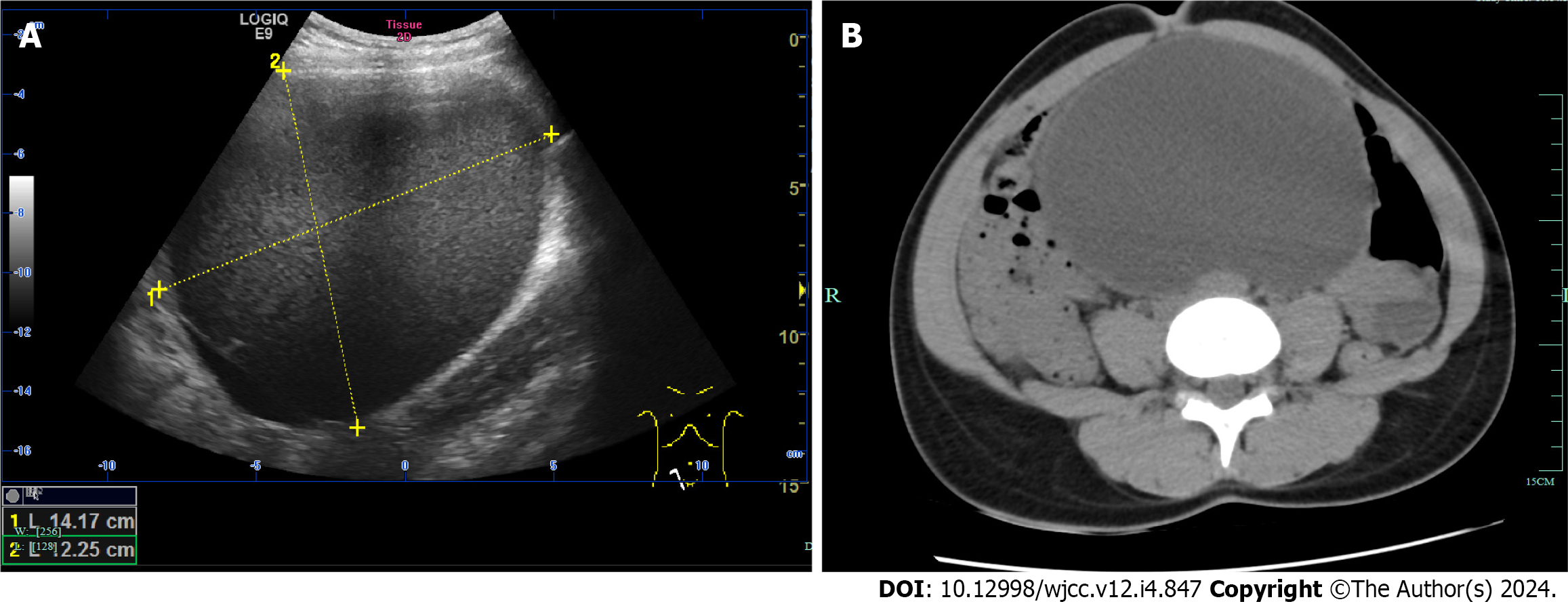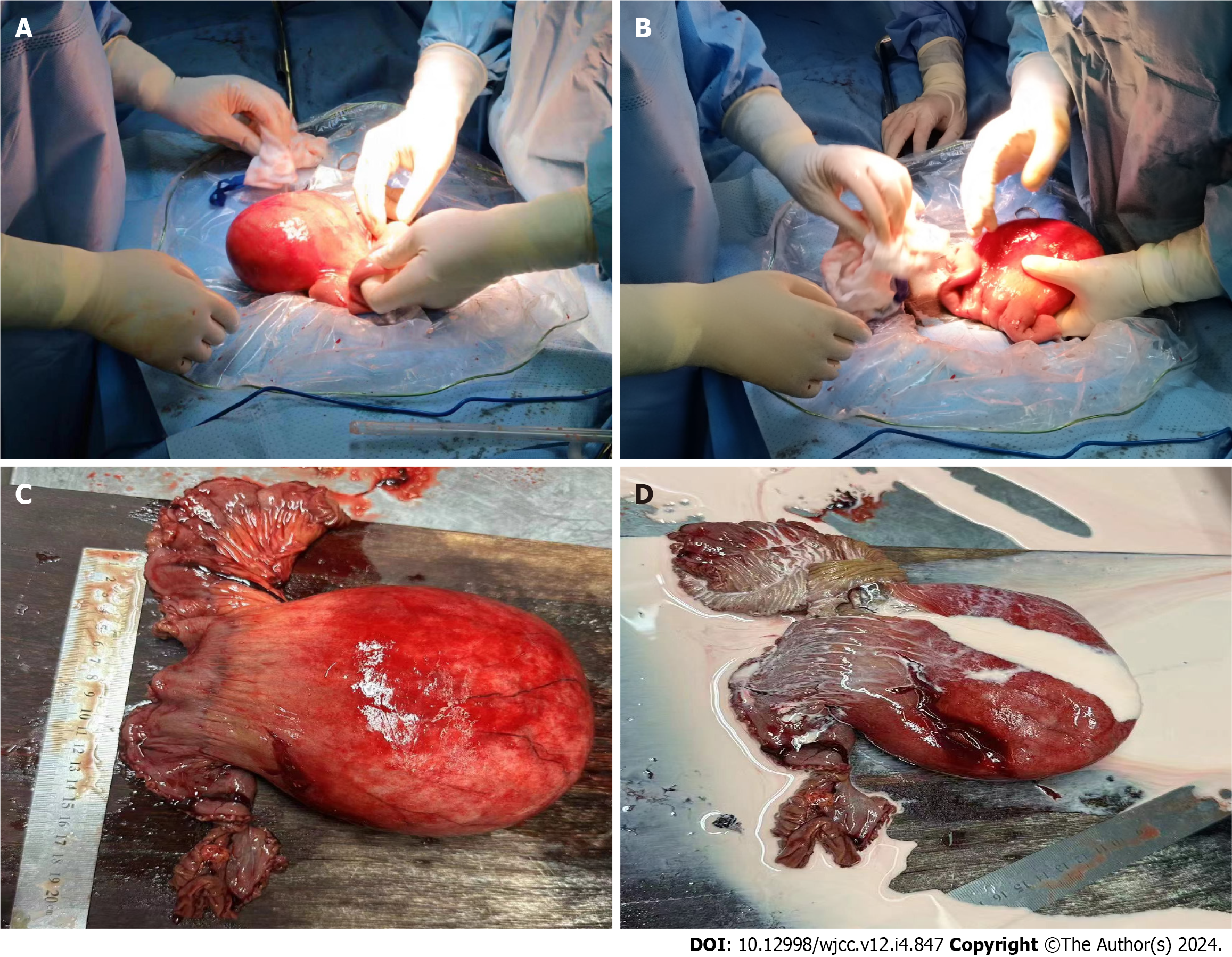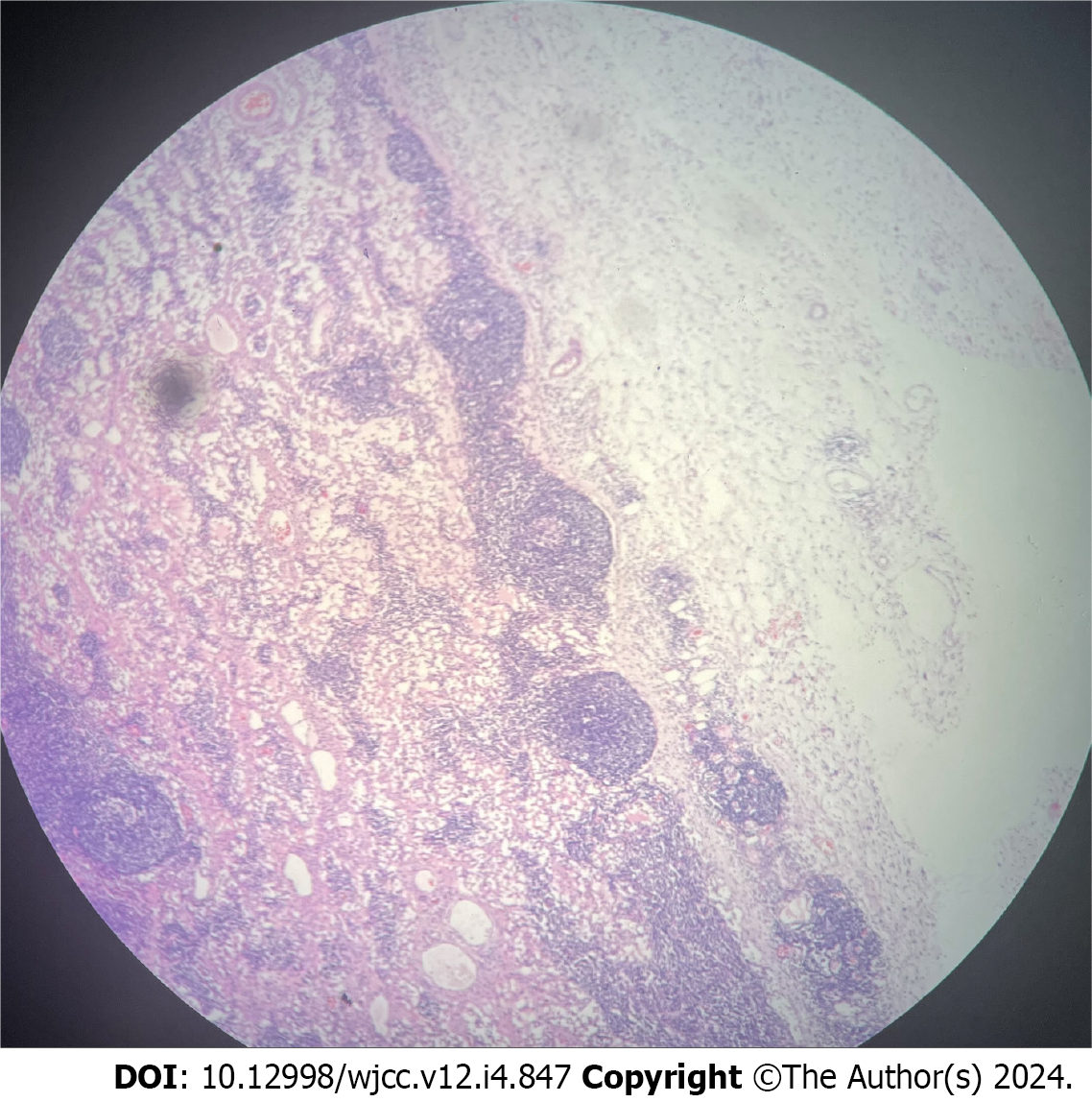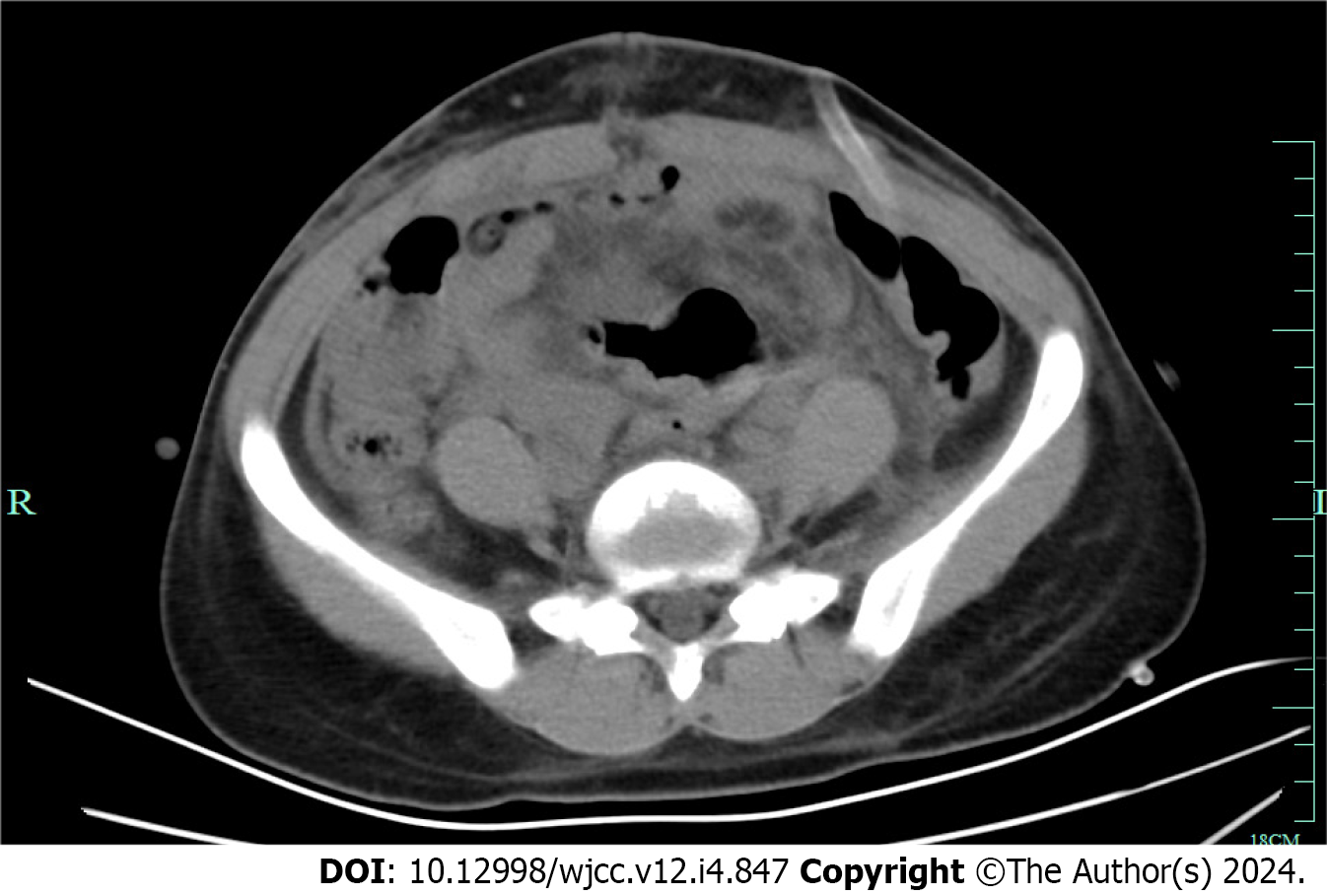Published online Feb 6, 2024. doi: 10.12998/wjcc.v12.i4.847
Peer-review started: November 6, 2023
First decision: December 20, 2023
Revised: December 22, 2023
Accepted: January 12, 2024
Article in press: January 12, 2024
Published online: February 6, 2024
Processing time: 80 Days and 0.9 Hours
Cystic lymphangioma is a rare benign tumor that affects the lymphatic system. Mesenteric lymphangiomas in the small bowel are extremely uncommon.
We present a 21-year-old female patient who complained of abdominal pain. The diagnosis of ovarian torsion was suspected after abdominopelvic unenhanced computed tomography and ultrasound revealed a large cyst in contact with the bladder, ovary, and uterus. The patient underwent emergency laparotomy per
Mesenteric lymphangiomas can cause abdominal pain, and imaging techniques can help determine their characteristics, location, and size. Complete surgical excision and pathological examination are considered the standard treatment and diagnostic method.
Core Tip: Cystic lymphangioma is a benign malformation tumor of the lymphatic system. Mesenteric lymphangiomas in the small bowel are rare.
- Citation: Xu J, Lv TF. Rupture of a giant jejunal mesenteric cystic lymphangioma misdiagnosed as ovarian torsion: A case report. World J Clin Cases 2024; 12(4): 847-852
- URL: https://www.wjgnet.com/2307-8960/full/v12/i4/847.htm
- DOI: https://dx.doi.org/10.12998/wjcc.v12.i4.847
Lymphangiomas are benign tumors which may evolve from congenital malformations of lymphatic vessels[1]. Lymphangiomas are rare cystic tumors which are usually located in the axilla and neck of children[2]. Mesenteric lymphangiomas of the small bowel in adults are extremely rare and are fewer than 1% of all lymphangiomas[3]. In this report, we present a case wherein the misdiagnosis of ovarian torsion occurred due to the rupture of a sizable jejunal mesenteric cystic lymphangioma.
A 21-year-old woman suffered abdominal pain for one day.
The patient suffered abdominal pain for one day.
She had no history of kidney disease, coronary heart disease, hypertension or diabetes.
No relevant personal or family history.
Tenderness was found around the umbilicus.
Most laboratory test results, including serum amylase, glutamic-pyruvic transaminase, and creatinine levels, were within normal limits. However, serum C-reactive protein level was significantly elevated (90 mg/L) (Table 1).
| Laboratory result | Normal | |
| WBC (× 109/L) | 7.9 | 3.4-9.5 |
| EO (× 109/L) | 0.05 | 0.4-8.0 |
| HB (g/L) | 129 | 115-150 |
| Platelet (× 109/L) | 351 | 125-350 |
| PT (s) | 11.6 | 9.7-13.5 |
| Dimer (mg/L) | 0.45 | 0.00-0.55 |
| ALT (U/L) | 13 | 9-50 |
| TB (μmol/L) | 14 | 3-20 |
| Cr (μmol/L) | 43 | 40-80 |
| CA199 (kU/L) | 16.8 | 0-35 |
| CEA (μg/L) | 0.3 | 0-5 |
| CRP (mg/L) | 90 | 0-10 |
| Amylase (U/L) | 91 | 35-135 |
| Lipase (U/L) | 84 | 0-190 |
| Glucose (mmol/L) | 5.6 | 3.0-6.1 |
| HbsAg | Negative | Negative |
| HIV Ab | Positive | Negative |
| Sp Ab | Negative | Negative |
| ANA | Negative | Negative |
| HC Ab | Negative | Negative |
Based on ultrasound (US) (Figure 1A) and abdominopelvic unenhanced computed tomography (CT) results (Figure 1B), the diagnosis of ovarian torsion was suspected. The imaging studies revealed a large cyst (14 cm × 12 cm) in contact with the bladder, ovary, and uterus.
The final diagnosis was cystic lymphangioma of the mesentery.
Emergency laparotomy was performed by gynecologists, but during the procedure, it was discovered that the cystic tumor originated from the jejunal mesentery (Figure 2A). A small rupture in the cyst led to the leakage of chylous fluid. Gastrointestinal surgeons were then called in to perform a cystectomy (Figure 2B-D). Pathological examination confirmed the diagnosis of cystic lymphangioma of the mesentery (Figure 3). The patient's postoperative recovery was uneventful (Figure 4).
The patient's postoperative recovery was uneventful.
Mesenteric cysts have a reported incidence ranging from one per 100000 to one per 250000 of in-patients[4]. Due to the lack of lymphatics, cystic lymphangiomas cannot affect the central nervous system[5]. The incidence of mesenteric lymphangiomas is approximately 1/20000 in children and 1/100000 in adults[6]. The cause of mesenteric lymphangiomas may be attributed to congenital abnormalities of the lymphatic system which induces sequestration of lymphatic tissues during development of the embryo[7]. However, other causes such as abdominal trauma, inflammation, lymphatic obstruction, and radiation therapy should be considered[8]. Mesenteric lymphangiomas are normally asymptomatic until they become large. The main symptoms include an abdominal mass and abdominal pain[9]. Histopathology of the surgical specimen may identify a unilocular or multilocular cyst containing serous or viscous fluid with cholesterol crystals, chylomicrons, and triglycerides encircled by a single layer of flattened immunoreactive mesothelial cells with cytokeratins and a fibrous wall with lymphocytes[10,11].
In this case report, the patient was asymptomatic prior to rupture of the cyst but experienced abdominal pain localized around the umbilicus. It is worth noting that abdominal pain can be associated with various other medical conditions, making it difficult to establish the accurate diagnosis based on symptoms. Moreover, no definitive blood tests are available to confirm the diagnosis. In this particular case, both unenhanced CT and US imaging revealed a large cyst in proximity to the bladder, ovary, and uterus. Unfortunately, the radiologist, sonographer, and gynecologist misdiagnosed the patient's condition as ovarian torsion. Consequently, it became evident that complete surgical excision of the cyst, followed by pathological examination, was necessary to achieve a definitive diagnosis and provide appropriate treat
Surgical excision can prevent potential malignant transformation, in addition to complications and recurrences[12]. Vigilance is imperative during the follow-up period to promptly detect any recurrence of mesenteric cystic lymphan
Mesenteric lymphangiomas can cause abdominal pain, and imaging techniques can help determine their characteristics, location, and size. Complete surgical excision and pathological examination are considered the standard treatment and diagnostic method.
Provenance and peer review: Unsolicited article; Externally peer reviewed.
Peer-review model: Single blind
Specialty type: Gastroenterology and hepatology
Country/Territory of origin: China
Peer-review report’s scientific quality classification
Grade A (Excellent): 0
Grade B (Very good): 0
Grade C (Good): 0
Grade D (Fair): D
Grade E (Poor): 0
P-Reviewer: Cocca S, Italy S-Editor: Zhang H L-Editor: Webster JR P-Editor: Zhao S
| 1. | Agha RA, Borrelli MR, Farwana R, Koshy K, Fowler AJ, Orgill DP; SCARE Group. The SCARE 2018 statement: Updating consensus Surgical CAse REport (SCARE) guidelines. Int J Surg. 2018;60:132-136. [RCA] [PubMed] [DOI] [Full Text] [Cited by in Crossref: 2076] [Cited by in RCA: 2072] [Article Influence: 296.0] [Reference Citation Analysis (0)] |
| 2. | Kitamura H, Yamamoto D, Kadoya S, Bando H, Okayama Y, Minato H. Jejunal mesenteric lymphangioma treated by pancreaticoduodenectomy: A case report. Int J Surg Case Rep. 2020;77:165-169. [RCA] [PubMed] [DOI] [Full Text] [Full Text (PDF)] [Cited by in Crossref: 6] [Cited by in RCA: 6] [Article Influence: 1.2] [Reference Citation Analysis (0)] |
| 3. | Erguney S, Teksoz S, Erdamar S, Ainechii S, Olgun DC. Extended pancreaticoduodenectomy for a huge cystic-cavernous lymphangioma: a case report. JOP. 2012;13:289-291. [PubMed] |
| 4. | Vanek VW, Phillips AK. Retroperitoneal, mesenteric, and omental cysts. Arch Surg. 1984;119:838-842. [RCA] [PubMed] [DOI] [Full Text] [Cited by in Crossref: 131] [Cited by in RCA: 115] [Article Influence: 2.8] [Reference Citation Analysis (0)] |
| 5. | Ouaïssi M, Emungania O, Sebbag H, Lehors-Albouz H, Boutboul R. [Cystic lymphangioma of the lesser omentum]. Presse Med. 2003;32:1165-1166. [PubMed] |
| 6. | Mabrut JY, Grandjean JP, Henry L, Chappuis JP, Partensky C, Barth X, Tissot E. [IMesenteric and mesocolic cystic lymphangiomas. Diagnostic and therapeutic management]. Ann Chir. 2002;127:343-349. [RCA] [PubMed] [DOI] [Full Text] [Cited by in Crossref: 44] [Cited by in RCA: 40] [Article Influence: 1.7] [Reference Citation Analysis (0)] |
| 7. | Yasoshima T, Mukaiya M, Hirata K, Takashima T, Kashiwagi K, Kukita K, Homma H, Niitsu Y. A chylous cyst of the mesentery: report of a case. Surg Today. 2000;30:185-187. [RCA] [PubMed] [DOI] [Full Text] [Cited by in Crossref: 11] [Cited by in RCA: 11] [Article Influence: 0.4] [Reference Citation Analysis (0)] |
| 8. | Suthiwartnarueput W, Kiatipunsodsai S, Kwankua A, Chaumrattanakul U. Lymphangioma of the small bowel mesentery: a case report and review of the literature. World J Gastroenterol. 2012;18:6328-6332. [RCA] [PubMed] [DOI] [Full Text] [Full Text (PDF)] [Cited by in CrossRef: 52] [Cited by in RCA: 61] [Article Influence: 4.7] [Reference Citation Analysis (0)] |
| 9. | Watanabe A, Suzuki H, Kubo N, Kobayashi T, Araki K, Sasaki S, Shimura T, Oyama T, Kuwano H. A case of mesenteric cystic lymphangioma in an adult which caused duodenal stenosis after resection. Int J Surg Case Rep. 2013;4:212-215. [RCA] [PubMed] [DOI] [Full Text] [Cited by in Crossref: 14] [Cited by in RCA: 15] [Article Influence: 1.2] [Reference Citation Analysis (0)] |
| 10. | Lee DL, Madhuvrata P, Reed MW, Balasubramanian SP. Chylous mesenteric cyst: A diagnostic dilemma. Asian J Surg. 2016;39:182-186. [RCA] [PubMed] [DOI] [Full Text] [Cited by in Crossref: 26] [Cited by in RCA: 31] [Article Influence: 3.4] [Reference Citation Analysis (0)] |
| 11. | Javed A, Pal S, Chattopadhyay TK. Chylolymphatic cysts of the mesentery. Trop Gastroenterol. 2011;32:219-221. [PubMed] |
| 12. | Cudia B, D'Orazio B, Calì D, Di Vita G, Geraci G. Lymphatic Mesenteric Cyst, a Rare Cause of Surgical Abdominal Pain: Case Report and Review of the Literature. Cureus. 2020;12:e11766. [RCA] [PubMed] [DOI] [Full Text] [Full Text (PDF)] [Cited by in Crossref: 1] [Cited by in RCA: 3] [Article Influence: 0.6] [Reference Citation Analysis (0)] |












